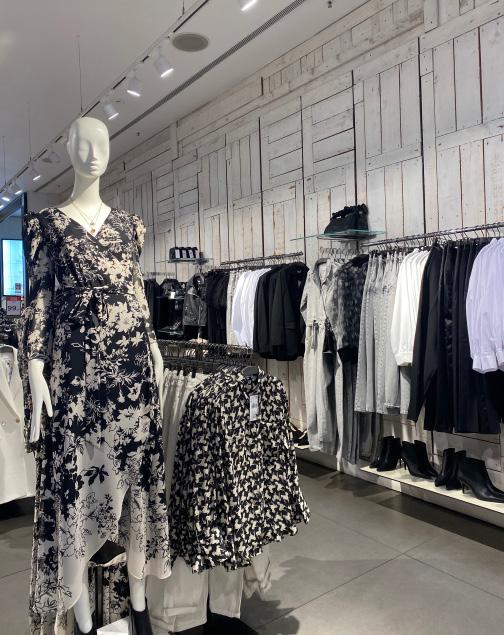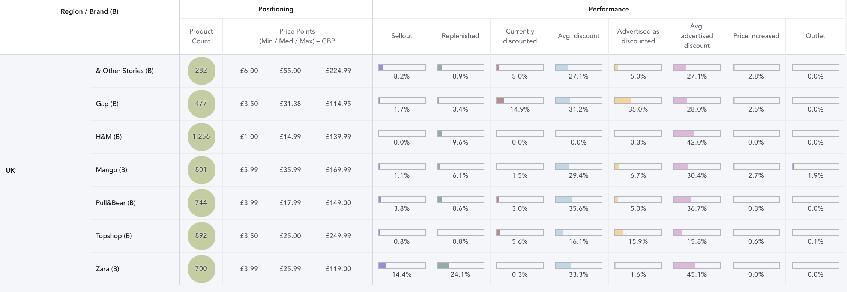
5 minute read
II. Market Research
SWOT Analysis
Strengths - “Committed” collection line is their sustainable womenswear line - Have a balanced range of product mix between core, fashion, and higher fashion pieces - Cost is mid-range, afordable which appeals to young, working customers - Unique designs of clothing with a cohesive brand image of contemporary Mediterranean style throughout - Recycling clothing drop-box - A good balance between seasonal clothing, showing that they appeal to all shoppers, not just UK shoppers - Organization of the clothing through type of wear and color coordination makes it easier to shop certain items - Outlet in flagship store put all markdown items in one area to shop
Advertisement
Weaknesses - No “Committed” menswear line - Very limited menswear and kids lines; 2 full floors of womenswear and 1 for combined mens and kids - Employees in the store aren’t addressing customers when they shop and asking if they need help - Window displays in the flagship store aren’t eye-catching and they only display one mannequin for men’s and one for women’s - Organization of the outlet clothing section is messy
Opportunities - More Menswear and kids wear clothing - Expanding “Committed” line to menswear, kids wear, and shoes - Increase marketing in store to promote the sustainable line - Updating the window displays to show more items and use as a marketing tool
Threats - Competition from other retailers and their better in-store marketing tools - Competitors like Zara, The GAP and H&M have more men as shoppers than Mango does - Segmentation of their brand is known as a women’s brand while they have other ranges

Figure 2.2: Display in Mango Oxford Street
Based on a comparative shop analysis of multiple Mango stores in London and the online website (See Appendix 1.1 and 1.2), the SWOT analysis shows the strengths and weaknesses of the current in-store product range, where they have opportunities for growth, and what threats Mango faces through the current collection. Based on observations, Mango’s product range is heavily focused on womenswear, as they started as a women’s fashion brand and that’s their main customer base. However, this also becomes a weakness when looking at the customer base of its main competitors like Zara and H&M who also have a larger womenswear line than men, yet still have more male customers (See Appendix 1.4). This weakness creates an opportunity to develop the menswear products and grow their “Committed” product line.
Competitive Analysis
Mango’s competitors include H&M, Gap, TopShop, & Other Stories, Pull&Bear, but its main competitor is Zara (See Figure 2.3). Zara is known to have trendy and fashion-forward garments that give customers a high-fashion feeling for a high-street price. Zara’s strengths include their reputation, their two-week product turnover, and their prices (See Appendix 1.3). Weaknesses include the sustainability of their two-week product turnover, designer-copied clothing items, and their lack of instore and omni-channel marketing. According to Edited Market Analytics (See Figure 2.4), Zara has had more sellouts and replenished items and less discounted items in the past month, compared to Mango’s data. This shows that the coronavirus pandemic afects Zara, in supply chain management, less than Mango, which is beneficial for Zara because they have a large enough customer base and strong supply chain that they can still sell items enough to be sold out and replenished again.

Figure 2.4: Market Strategies of Mango’s and its competitors (Edited, 2020b) Figure 2.3: Positioning Map (based on median prices shown in Figure 2.4)

Customer Profile
Figure 2.5: Customer Profile The “Mango Man” is around the age of 18- 25 years old, definitely younger than 30. He is either a student in university or is an educated young professional, working a white-collar job. He is any race, ethnicity, and sexual orientation. His income, whether working part-time because he’s a student or full-time, is on average around £2000 (Stotz, 2019). His family status is that he has prospects of having kids in the future but is not planning on starting a family until he makes enough money to support a family, with the help of his significant other.

He lives in the urban cosmopolitan areas of the United Kingdom where he lives in an apartment building or in a private student accommodation (CACI, 2014, p. 64). The area he lives in his highly populated, since it’s a city. In the spring and summer, the city gets slightly warm with a breeze, allowing flocks of people to hang out in parks and out on their terraces.
He values eco-friendly businesses but may not necessarily buy solely sustainable items. He is aware of how wasteful the fashion industry, so he doesn’t like to buy a lot of items at a time from the brands he shops at. While he’s not at school or work he likes to hang out with friends, go to cofee shops, eat out at young, happening restaurants, go to the gym, and travel to new places. In the summer, he likes to go to the beach, travel to places like Spain, Italy, or Amsterdam where he can relax and enjoy his time of from school or work. He will usually shop at places like Zara, Top Man, River Island, and H&M for trendy items and workwear attire. He has social media accounts, but only posts sometimes (CACI, 2014, p. 62).
With this new Spring/Summer 2021 collection, he will be looking for benefits of being trendier, being more sustainable, while expanding the color palette in his closet. He has purchased from Mango before, but usually for workwear or outerwear items and not really for on-trend pieces. He will be able to wear these pieces in the spring and summer, but he will make use of them in autumn and winter by layering them with heavier materialized garments. He is a little bit weary to make purchases for spring/summer clothing because the Coronavirus pandemic has left him unsure for what the summer holds, however he wants to expand his closet into more fun items as he hopes for a virus-free summer.






